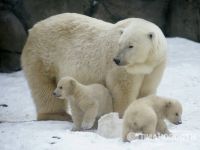Canada's unsustainable slaughter of polar bears
OTTAWA, Ontario (Jan. 30, 2013) - A new Environics poll commissioned by Humane Society International and the International Fund for Animal Welfare shows that the vast majority of Canadians support the proposal to prohibit the international commercial trade of polar bear parts by uplisting the animals to Appendix I of the Convention on International Trade in Endangered Species. Canada is the only country in the world to still allow its polar bears to be shot and sold on the global market. Canadian support for the uplisting of polar bears rose to 85 percent from 82 percent in comparison to a similar poll conducted by Environics in 2010.

The poll results come in advance of the 16th Meeting of the Conference of the Parties (CoP16) to CITES, 3-14 Mar. 2013, where delegates from Canada and other signatories will vote on uplisting. The proposal has been made by the United States and is supported by Russia; both countries also have polar bear populations. DEFRA Minister Richard Benyon recently confirmed that the UK also supports the proposal. The Canadian government opposes the proposal, and has been working to undermine international efforts to garner the maximum protection for polar bears. Canadians' disapproval of their government's plan to oppose the uplisting has increased significantly from 61 percent to 72 percent.
"On the heels of the recent pledge from DEFRA to support efforts to ban the international trade in polar bear products, this new poll shows that Canadians themselves are aware that while climate change is the top threat to polar bears, killing them for trophies, rugs and trinkets is not only inhumane but also unsustainable," said HSI/UK's Executive Director Mark Jones. "We urge the Canadian government to listen to the international scientific community and the vast majority of its own citizens who want to see polar bears receive the maximum protection."
"EU Member States need to listen to the science and they need to listen to their citizens - both point very clearly to stopping the international commercial trade in polar bear products," said IFAW EU Director Sonja Van Tichelen. "The EU has 27 votes at CITES and the heft to swing the result in either direction - they must choose a legacy of conservation and a future that includes polar bears."
The international trade in polar bear parts results in the deaths of 441 polar bears every year on average in Canada.
A telephone survey was conducted between Jan. 2 and Jan. 11, 2013 with a sample size of 2,007 adults (18 years and over), randomly selected from across Canada. The survey has a margin of sampling error of plus or minus 2.2 percentage points, at the 95 percent confidence level.
Facts:
Canada is the only country that allows legal hunting of polar bears solely for the purpose of international trade and sport (Peacock et al. (2011)). Each year, approximately 600 polar bears are hunted in Canada (Peacock et al. (2011)) and on average the parts of 441 are internationally traded. This level of hunting has negatively affected some polar bear populations.
Polar bears in Canada are composed of 13 separately managed populations. According to the IUCN Polar Bear Specialists Group (PBSG), which is composed of the world's foremost polar bear scientists, over half of these populations are declining. Only three populations are stable. Two are data deficient. And only one population, which represents a mere 2 percent of Canada's bears, is increasing - due largely to a reduction in quota spurred by overhunting. IUCN/SSC Polar Bear Specialist Group (PBSG),
Canada kills polar bears at unsustainable levels, resulting in declines in more than half of Canada's polar bear populations. Hunt quotas for any population that is declining are by definition unsustainable. In addition, Canada acknowledges that it kills 3.75 percent of its bears every year, but the maximum rate of population growth for polar bears is between 4 percent and 6 percent per year. Even in healthy growing populations, an annual hunt quota of 3.75 percent would slow, and possibly even stop, that growth.
Polar bear quotas in Canada are set by Provincial and Territorial wildlife management boards. While these boards take scientific advice into account, the quotas they set are not limited by that advice.
While climate change is the top threat to polar bears, the international commercial trade in parts is the second biggest threat to the species, resulting in the deaths of 441 bears a year on average. It is a fundamental tenet of conservation biology that in order to help species challenged by habitat degradation and climate change, other population stressors must be reduced.
From 2007 to 2012, there was a 375 percent increase in the number of polar bear skins offered at auction, and rising and unsustainable hunting quotas and killing levels are likely motivated in part by the growing international demand for polar bear hides.
Source: HSI
Humane Society International/Canada is a leading force for animal protection, representing tens of thousands of members and constituents across the country. HSI/Canada has active programs in companion animals, wildlife and habitat protection, marine mammal preservation and farm animal welfare. HSI/Canada is proud to be a part of Humane Society International-one of the largest animal protection organizations in the world, with more than eleven million members and constituents globally.
Subscribe to Pravda.Ru Telegram channel, Facebook, RSS!


